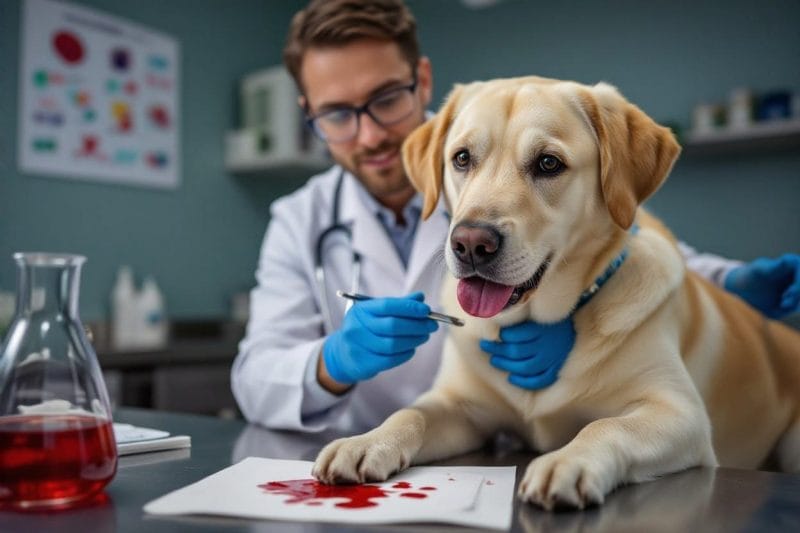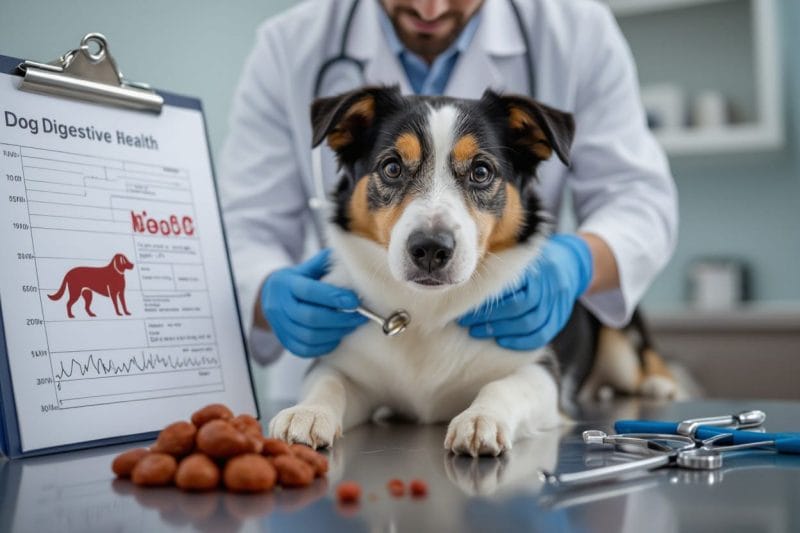You may feel alarmed if you notice blood in your dog’s stool, as it can indicate a variety of health issues. Understanding the possible causes—from dietary indiscretion to infections or serious diseases—can help you determine the best course of action. This guide will walk you through common reasons why your dog might be pooping blood and outline practical steps you can take to ensure your pet receives the proper care promptly.
Key Takeaways:
- Blood in a dog’s stool can originate from various causes including dietary indiscretion, infections, parasites, cancer, or blood clotting disorders.
- The appearance of the blood—bright red (hematochezia) or black and tarry (melena)—helps indicate where the bleeding is occurring in the digestive tract.
- If your dog is pooping blood accompanied by symptoms like vomiting, lethargy, pale gums, or refusal to eat, seek veterinary care immediately to prevent serious complications.

The Alarming Reality of Blood in Dog Stool
Blood in your dog’s stool is not just messy—it signals potential health issues ranging from mild irritation to serious internal problems. Bright red blood often points to inflammation or injury in the lower gut, while dark, tarry stool suggests bleeding higher up in the digestive tract. Some cases may involve parasites, infections, or even cancers. The urgency to act grows if you notice additional signs like lethargy, vomiting, or pale gums, which could indicate dangerous blood loss or dehydration. Knowing the implications helps you take timely steps to protect your dog’s health.
Common Gastrointestinal Triggers
Dietary indiscretion is a frequent trigger behind bloody stools, whether from swallowing foreign objects like bones, sticks, or toxins, or from sudden dietary changes such as switching foods or introducing raw diets. Gastroenteritis and acute hemorrhagic diarrhea syndrome can result from these factors, causing inflammation anywhere from the stomach to the colon. Viral and bacterial infections, plus parasites like giardia or intestinal worms, also provoke bleeding. Knowing these common triggers can help identify potential causes and guide early treatment.
External Factors and Underlying Health Issues
Bleeding in your dog’s stool can stem from systemic conditions affecting clotting or organ function rather than just the digestive system. Rodenticide poisoning, liver or kidney diseases, immune-mediated thrombocytopenia, and hormonal disorders like Addison’s disease interfere with normal blood clotting and can cause hemorrhaging. Stress, trauma, and tumors also contribute. Knowing these factors broadens your understanding of what might be endangering your dog beyond just gut irritation.
- Rodenticide exposure can cause severe internal bleeding rapidly.
- Immune system diseases may destroy platelets vital for clotting.
- Liver and kidney failure disrupt toxin clearance, increasing bleeding risk.
- Stress and trauma can exacerbate existing vulnerabilities.
Knowing these details can improve your vigilance and communication with your veterinarian.
Systemic illnesses like immune-mediated thrombocytopenia (ITP) present a unique challenge, as your dog’s platelet count drops dramatically, impairing clotting and leading to spontaneous bleeding, including bloody stools. Addison’s disease disrupts cortisol production, weakening the body’s stress response and potentially causing ulcerations in the GI tract that bleed. Rodenticide poisoning—sometimes subtle at first—interferes with vitamin K dependent clotting factors, rapidly leading to life-threatening hemorrhage. Chronic liver or kidney disease impairs production of clotting proteins and toxin clearance, making it harder for the body to control bleeding. Your dog’s stress levels and physical trauma also influence bleeding severity, especially if cancer or anal gland issues are present, complicating diagnosis and treatment.
- Immune disorders may require lifelong medication and monitoring.
- Endocrine testing often helps diagnose hormonal imbalances contributing to bleeding.
- Early detection of toxin exposure can prevent fatal outcomes.
- Stress management and trauma prevention aid recovery.
Knowing these nuances helps tailor your dog’s care plan and improves recovery chances.
Identifying the Type of Blood in Your Dog’s Stool
Noticing blood in your dog’s stool can be unsettling, but distinguishing the type of blood can offer important clues about where the problem lies. Blood appearing bright red usually points to issues in the lower digestive tract, while darker, tar-like stool suggests bleeding further up, like the stomach or small intestine. Recognizing these differences helps you provide your vet with precise information to guide diagnosis and treatment.
Hematochezia: Bright Red Blood Indicating Lower GI Distress
Bright red blood, or hematochezia, shows the bleeding source is likely in the colon, rectum, or anus. This fresh blood often coats the stool or appears as streaks, sometimes mixed with mucus. Dogs with hematochezia often have increased frequency of bowel movements, which can range from soft to watery, signaling inflammation, infection, or even trauma in the lower GI tract.
Melena: Dark Tarry Stool Signaling Upper GI Problems
Melena refers to black, tarry stool caused by digested blood from bleeding in the stomach or small intestine. The dark color results from blood breaking down as it travels through the digestive system, often indicating ulcers, tumors, or severe inflammation in these upper GI areas.
Melena can sometimes be mistaken for harmless dark stool, but its presence often signals a more serious issue, such as gastric ulcers or bleeding tumors. Because the blood has been partially digested, the stool may have a distinct, foul odor and appear sticky or tar-like. If you observe melena, your dog may also show signs of anemia or weakness, making prompt veterinary evaluation important to identify and treat the underlying cause effectively.
Immediate Action: When to Consult Your Veterinarian
If your dog’s stool shows any signs of blood, reaching out to your vet quickly can help determine the urgency. Blood in the stool paired with symptoms such as vomiting, lethargy, or pale gums typically demands prompt veterinary attention. Even if your dog seems otherwise fine, ongoing or heavy bleeding shouldn’t be ignored. Early assessment helps identify the source of bleeding and prevents complications like dehydration or anemia.
Symptoms That Warrant Urgent Care
Signs like persistent vomiting, refusal to eat or drink, pale or white gums, weakness, and straining to defecate with little to no output indicate a serious problem. If your dog becomes unresponsive or shows signs of shock, getting emergency veterinary care without delay becomes important to prevent life-threatening consequences.
Assessing At-Home Care Options
Mild cases of blood in the stool may stem from harmless causes such as eating red-colored treats or minor dietary changes. Observing your dog closely for any additional symptoms or worsening signs over 24 to 48 hours can guide whether home care suffices or a vet visit is needed. Keeping track of your dog’s eating habits and stool appearance provides valuable clues.
At-home monitoring can involve withholding food for 12 to 24 hours, followed by reintroducing a bland diet like boiled chicken and rice. Avoid giving medications unless prescribed. Hydration should be maintained with fresh water, but any signs of dehydration, increased bleeding, or behavioral changes should prompt immediate veterinary evaluation. Detailed notes on what your dog ate or any exposure to toxins will also help your vet diagnose the problem accurately.

Diagnostic Pathways and The Vet’s Approach
Your veterinarian will take a methodical approach, starting with a detailed history and physical examination to pinpoint potential causes of blood in your dog’s stool. From there, tailored diagnostics help narrow down whether the issue lies in the gastrointestinal tract, a systemic disease, or a clotting disorder. This structured process guides which treatments will be most effective and how urgent the condition may be.
Essential Physical Exam and Testing
The exam typically includes a rectal check to identify tumors, foreign objects, or anal gland problems, alongside abdominal palpation to detect pain or swelling. Common tests run include stool analysis for parasites and bacteria, SNAP tests for giardia and parvovirus, blood work to assess anemia and hydration, and imaging like X-rays or ultrasounds for masses or obstructions.
Potential Findings and Further Investigations
Depending on initial exam and test results, additional diagnostics such as fecal cultures, endocrine panels (e.g., cortisol for Addison’s disease), or advanced procedures like endoscopy may be needed to visualize and biopsy affected areas, uncovering underlying causes not apparent through basic tests.
For example, endoscopy allows your vet to directly inspect the upper and lower GI tract lining, identifying ulcers, inflammation, or tumors. Biopsies taken during this procedure can confirm diagnoses like inflammatory bowel disease or cancer, which often require long-term management. In complex cases, combining blood work with imaging helps differentiate between infectious causes, immune disorders, or malignancies, ensuring your dog receives targeted treatment aligned with the exact diagnosis.

Treatment Strategies Tailored to Cause
Treatment for bloody stool varies broadly based on the underlying issue. Whether blood results from a simple dietary upset, an infection, or a clotting disorder, your vet will customize the approach accordingly. Targeted therapies might include dietary changes, antimicrobial medications, fluid therapy, or even surgery. Understanding the cause through diagnostic tests helps you work with your vet to apply the most effective solution, supporting faster healing and preventing recurrence.
Managing Gastrointestinal Upsets
For inflammation or mild gastroenteritis, vets often recommend a bland, easy-to-digest diet combined with probiotics or prebiotics to restore gut balance. In some cases, antibiotics or antacid medications like Famotidine or Omeprazole help reduce stomach acid and promote healing of ulcers, easing symptoms and stopping bleeding.
Addressing Dehydration and Blood Loss
When blood loss or severe diarrhea leads to dehydration, fluid therapy becomes crucial. Mild dehydration typically responds to subcutaneous fluids at home, but more severe cases require intravenous fluids and hospitalization to stabilize your dog and prevent shock.
Intravenous fluid therapy is key for dogs experiencing significant blood loss or dehydration from vomiting and bloody stools. It rapidly restores vital blood volume and electrolytes, maintaining blood pressure and organ perfusion. Hospitals monitor your dog closely during IV treatment, often alongside blood transfusions if anemia is severe. This intensive care supports recovery and buys time to address the underlying cause through medications or surgery.
Summing up
From above, seeing blood in your dog’s stool can indicate a range of health issues, from minor digestive upset to serious conditions affecting their digestive tract or blood clotting. You should closely monitor your dog’s symptoms and seek veterinary care if blood is persistent, accompanied by signs like vomiting, lethargy, or pale gums. Early consultation with your vet helps identify the cause, guide treatment, and support your dog’s recovery, ensuring they get the care they need to stay healthy and comfortable.
FAQ
Q: What are some common reasons my dog might be pooping blood?
A: Blood in a dog’s stool can be caused by several factors, including eating something harmful or switching to a new food, infections or parasites that affect the digestive tract, gastrointestinal diseases like ulcers or cancer, bleeding disorders, toxins such as rodenticide poisoning, and other health issues like stress or anal gland problems.
Q: How can I tell if the blood in my dog’s stool is coming from the upper or lower digestive tract?
A: The appearance of the blood can help determine its source. Bright red blood, called hematochezia, usually indicates bleeding in the lower digestive tract such as the colon or rectum. Dark, black, and tarry stool, known as melena, generally suggests bleeding from the upper digestive tract like the stomach or small intestine.
Q: When should I take my dog to the vet if I notice blood in their stool?
A: You should seek veterinary care immediately if your dog shows additional symptoms such as lethargy, pale gums, vomiting, difficulty or straining during bowel movements, loss of appetite, or unresponsiveness. These signs may indicate a more serious health problem requiring urgent attention.
Q: Can at-home care help if my dog is pooping blood?
A: In some mild cases, especially if the blood appearance might be caused by eating foods like beets or red-dyed treats, monitoring your dog at home may be appropriate while noting any other symptoms. However, it is important to consult your veterinarian to determine whether your dog needs an exam or treatment.
Q: What treatments are available for dogs pooping blood?
A: Treatment depends on the underlying cause. For digestive upset, a vet may recommend a bland diet along with probiotics, prebiotics, or antibiotics. Medications such as antacids or ulcer treatments may be used if needed. Dehydration is treated with fluid therapy, which can range from subcutaneous fluids at home to intravenous fluids in hospital settings. More severe conditions might require advanced diagnostics, surgery, or long-term medication.









